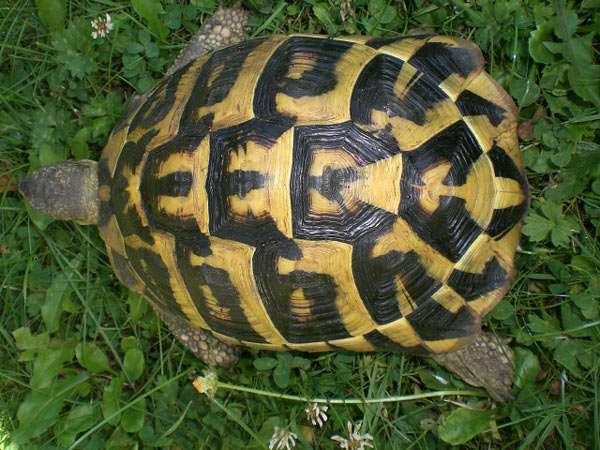Hermann's tortoise
GeneralThe Hermann tortoise is the only tortoise of France: it is present in the plain and the Massif des Maures (Var), and Corsica. If it looks like its cousins in Italy and Spain, and Corsica, they are genetically different, however, turtles and the Hermann tortoise Var is unique in the world.
There are two main subspecies:
Testudo hermanni hermanni:
It measures 18 to 20 cm in adult height (the male being slightly smaller than the female). The yellow color predominates on the shell, in contrast with the dark spots on it. The tail is longer in males. It is distinguished from other turtles by strips of black continuous in the plastron. She lives in Spain to Italy via the Mediterranean islands (Sardinia, Corsica, Balearic Islands)
Testudo hermanni boettgeri:
size can reach 28 cm, and weighs 3-4 kg tapes under the plastron is more sparse. His head goes from brown to black, with thin shells and on the front legs equipped with claws 5. She lives in South East Europe: Croatia, Macedonia, Romania, Bulgaria, Greece and Turkey.
BehaviorLife expectancy in the wild turtles is unknown. In captivity it can reach 100 years, most often between 60 and 80 years. This longevity is due to a metabolism adapted to external conditions but also by the fact that if they survive the first 6-7 years of their lives, they no longer fear predators then who face the problem of the shell .. . except human, of course, machinery and domestic dogs (who see them as bones to gnaw and cause stress injuries + fatal).
Turtles are cold-blooded animals (ectotherms) that must adjust to room temperature for proper metabolism and optimal activity. If it is cold, they must first find a place to warm up. If it's too hot, they must always be put in the shade. In nature, they are also long distances to drink regularly.
Have a good sense of direction, they are perfectly locate in space thanks to the magnetic fields of the earth and sun, and probably with a very good olfaction and memory of their environment.
Turtles are extremely attached to their place of living (phylopatrie), so they always try to return if they are on the move.
FoodLeaves, flowers, fruits, sometimes snails and worms.
HibernationIn the Mediterranean countryside, protected turtles dig their hibernation at the foot of a bush, and change from year to year, even if they seem still hibernate in the same area of their home range. They hibernate from November to February. At that time, heart rate and respiration are lowered significantly, they do not sleep per se, but rather a kind of lethargy. Turtles also need to hibernate in captivity, the vital need for them.
Reproduction:Males and females live solitary lives and are found only for mating. Courtship includes bites and shell shock which, if they do not pose a problem in nature (the female can escape), can cause serious injury to the female in captivity. The female may mate with several males during one season, and keep intact sperm during 4-5 years in the folds of her reproductive system. Thus, even if it does not mate, she retains the power to lay fertilized eggs while males are absent or scarce. It is this complex that parade, as in many other animals, females can assess the qualities of the male coupling and deny it does not suit him ...
Reproduction does not establish the sex of embryos. It depends on the incubation temperature. The average temperature generating as many males than females is 31.5 ° C. The female digs a hole with his hind legs and then lays eggs 35 mm in diameter and 16 g weight. There are on average 1-5 eggs, but if the female is older she will lay twice a year. The proportion of clutches arriving at birth is relatively low because of egg predation by different animals is high (weasel, wild boar, badger). Maturation of the eggs takes about 90 days, usually small emerging after the first rains of autumn.
Trade:His business was totally banned in France since a 1985 decree on the protection of wildlife French.
CaptivityThe detention of this kind is allowed up to 6 adult individuals requesting a Certificate of Approval Breeding (AEA) in the Directorate of Veterinary Services [4] in your department. Beyond this number of six adults is required to obtain a certificate of competency.
The sale is prohibited, the donation is allowed (records / O is to maintain and a simple declaration form of transfer is to be provided with the turtle to trace his route in case of successive assignments. If the turtle has CITES registration number must also be provided with the sale of the individual as all documents relating to the past of the turtle.
The sale of wild living or dead is prohibited, as well as the sale of live or dead wild eggs. Individuals from breeding (captive-born parents) are authorized for sale under certain conditions of administrative regulation.
The samples in the wild is prohibited, as well as release.



